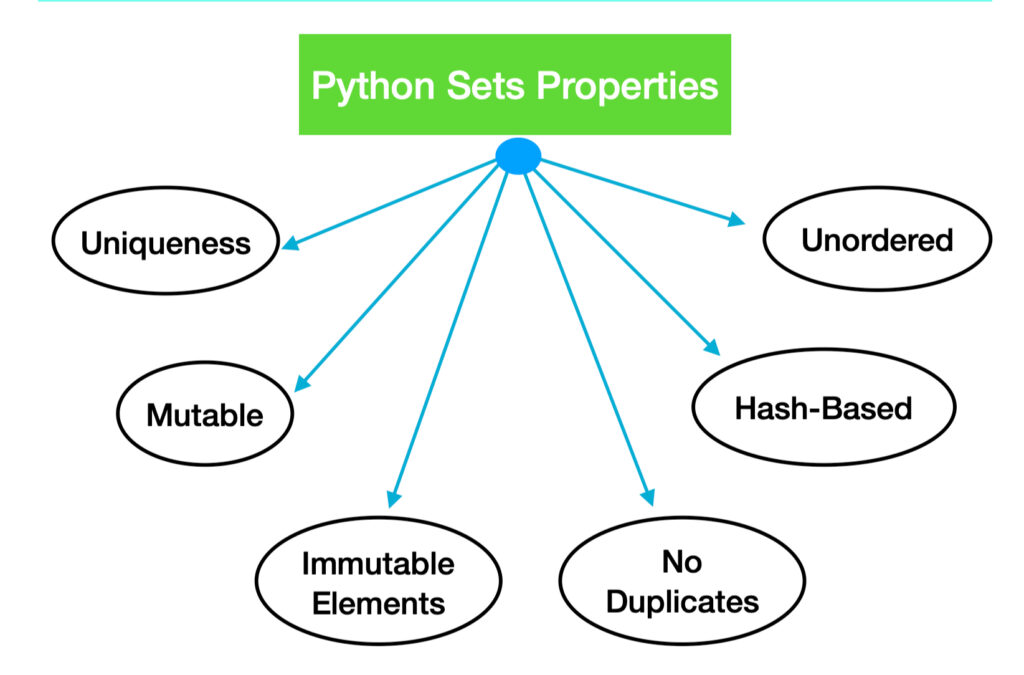Python is a versatile programming language offering a range of data structures to suit different needs. Two of the most powerful and commonly used structures are sets and dictionaries. These unordered collections allow for efficient data manipulation and are foundational for many Python applications.
This guide dives deep into the concepts, functionalities, differences, and real-world uses of Python set and dictionary, offering a complete overview for beginners and advanced users alike.
In programming, choosing the right data structure can optimize performance and readability. Python provides both sets and dictionaries as built-in unordered data types.
- A set is a collection of unique, immutable elements.
- A dictionary is a key-value store used to map data efficiently.
Both are incredibly useful for data lookup, filtering, and efficient computation.
What is a Python Set?
A Python set is an unordered collection of unique, immutable elements used for fast membership testing and duplicate removal.

A Python set is an unordered collection of unique items. Unlike lists or tuples, sets do not allow duplicate entries. They are highly optimized for checking membership and eliminating duplicate data.
Characteristics:
- Unordered
- No duplicate elements
- Mutable (can be changed)
- Elements must be immutable
Creating a Set in Python
Sets can be created using curly braces {} or the set() constructor, with only immutable elements allowed.
# Using curly braces
fruits = {"apple", "banana", "cherry"}
# Using set constructor
numbers = set([1, 2, 3, 4])
To create an empty set:
empty_set = set()
Using {} creates an empty dictionary instead.
Set Operations and Methods
Python sets support various mathematical operations like union, intersection, and difference, enabling efficient data comparison and filtering.
- Union: Combines elements from two sets
set1 | set2 or set1.union(set2) - Intersection: Returns common elements
set1 & set2 or set1.intersection(set2) - Difference: Elements in one set but not in the other
set1 - set2 or set1.difference(set2) - Symmetric Difference: Elements in either set, but not both
set1 ^ set2 or set1.symmetric_difference(set2)
Subset and Superset Checksset1.issubset(set2)
set1.issuperset(set2)
Other Methods:
add()remove()discard()pop()clear()
Real-Life Use Cases of Python Sets
Sets are ideal for removing duplicates, testing membership, and filtering large datasets quickly.
Removing Duplicates:names = ["John", "Jane", "John"]
unique_names = list(set(names))
Membership Testing:if "apple" in fruits:
print("Yes")
Efficient Filtering:banned_users = {"bot1", "bot2"}
active_users = [u for u in all_users if u not in banned_users]
What is a Python Dictionary?
A dictionary in Python is a mutable, unordered collection of key-value pairs for fast lookups and efficient mapping. Each key must be unique and immutable, and each value can be of any type.
Syntax:
student = {"name": "Alice", "age": 22, "courses": ["Math", "CS"]}
Characteristics:
- Keys are unique
- Values can be duplicates
- Mutable
- Fast lookups
Creating a Dictionary in Python
Dictionaries can be created using curly braces or the dict() constructor, with unique keys and flexible value types.
# Using literal
person = {"name": "Bob", "city": "NYC"}
# Using dict()
data = dict(name="Bob", city="NYC")
Adding elements:
data["age"] = 30
Dictionary Operations and Methods
Python dictionaries offer efficient value access, updates, deletions, and built-in methods like keys(), items(), and get().
- Accessing Values:
person["name"] - Updating Values:
person["age"] = 31 - Removing Elements:
person.pop("age")
Iteration:for key, value in person.items():
print(key, value)
Other Useful Methods:
keys()values()items()update()clear()
Real-Life Use Cases of Python Dictionaries
Dictionaries are widely used for storing user profiles, counting elements, and managing application configurations.
- User Profile Management
user = {"username": "admin", "permissions": ["read", "write"]}
Counting Frequency
from collections import Counter
count = Counter(["apple", "apple", "banana"])
- Configuration Storage
config = {"theme": "dark", "language": "en"}
Comparing Set and Dictionary in Python
Sets store unique items, while dictionaries map unique keys to values—both optimized for fast access and lookup.
| Feature | Set | Dictionary |
| Data Structure | Collection of unique items | Key-Value pair |
| Mutability | Mutable | Mutable |
| Syntax | {} or set() | {} or dict() |
| Duplicate Elements | Not Allowed | Keys must be unique |
| Use Case | Membership test, removing duplicates | Fast lookups, data mapping |
Python Set and Dictionary Best Practices
Follow clean coding practices like using immutable keys, dictionary comprehensions, and avoiding modifications during iteration.
- Always use immutable keys in dictionaries.
- Avoid modifying a set or dictionary while iterating.
- Use dictionary comprehensions for clean code.
- Use
setdefault()andget()to avoid key errors in dicts.
Characteristics of Python Sets
Python sets are powerful, unordered collections optimized for fast membership testing. Their internal implementation using hash tables makes them efficient and ideal for tasks involving uniqueness or filtering.
Key Characteristics
1. Unordered
- Set elements do not maintain a fixed order.
- Order may change after insertions/removals.
2. No Duplicate Elements
- Sets automatically remove duplicate items.
s = {1, 2, 2, 3}
print(s) # {1, 2, 3}
3. Mutable Collection
- You can add or remove elements from a set.
- But the elements inside a set must be immutable.
4. Elements Must Be Immutable
Allowed types:
✔ int
✔ float
✔ string
✔ tuple
✔ boolean
Not allowed:
✖ list
✖ dictionary
✖ set
5. Optimized for Fast Membership Testing
Checking “apple” in fruits is O(1) on average.
6. Supports Mathematical Set Operations
Union, intersection, difference, symmetric difference—all fast and concise.
Set Methods and Examples (Complete List)
Below is a comprehensive and blog-ready list of all important Python set methods with examples.
1. add()
Adds a single element.
s = {1, 2}
s.add(3)
# {1, 2, 3}
2. update()
Adds multiple elements.
s.update([3, 4, 5])
# {1, 2, 3, 4, 5}
3. remove()
Removes an element; throws error if not present.
s.remove(3)
4. discard()
Removes element; no error if missing.
s.discard(10)
5. pop()
Removes a random element.
item = s.pop()
6. clear()
Empties the set.
s.clear()
Set Operations
Union
a | b
a.union(b)
Intersection
a & b
a.intersection(b)
Difference
a - b
a.difference(b)
Symmetric Difference
a ^ b
a.symmetric_difference(b)
Other Utility Methods
| Method | Purpose |
issubset() | Check if set1 is inside set2 |
issuperset() | Check if set1 contains set2 |
isdisjoint() | True if no elements in common |
copy() | Returns shallow copy |
What is Frozen Set in Python?
A frozenset is an immutable version of a set.
Characteristics
- Immutable → cannot add or remove elements
- Hashable → can be used as dictionary keys
- Ideal for fixed sets of values (e.g., permissions, categories)
Creating a frozenset
fs = frozenset([1, 2, 3])
print(fs)
Allowed operations
- union
- intersection
- difference
- membership test
Not allowed
fs.add(4) # Error
fs.remove(2) # Error
Use Case Examples
✔ As dictionary keys
✔ Storing configuration that should not change
✔ Safe inputs in multiprocessing
Python Set Problems With Solutions
Perfect for adding to your blog as practice exercises.
Problem 1: Remove Duplicates from a List
nums = [1, 2, 2, 3, 3, 4]
unique = list(set(nums))
print(unique)
Problem 2: Find Common Elements Between Two Lists
a = [1, 2, 3, 4]
b = [3, 4, 5]
result = set(a) & set(b)
print(result) # {3, 4}
Problem 3: Check If Two Sets Are Disjoint
s1 = {1, 2}
s2 = {3, 4}
print(s1.isdisjoint(s2)) # True
Problem 4: Keep Only Even Numbers
data = {1, 2, 3, 4, 5, 6}
even = {x for x in data if x % 2 == 0}
Problem 5: Count Unique Words in a Sentence
text = "python is easy and python is powerful"
unique_words = set(text.split())
print(len(unique_words))
Remove Multiple Elements from a Set (All Methods)
1. Using difference_update()
s = {1, 2, 3, 4, 5}
remove_items = {2, 4}
s.difference_update(remove_items)
print(s)
2. Using a loop
for item in remove_items:
s.discard(item)
3. Using set comprehension
s = {x for x in s if x not in remove_items}
Append Multiple Elements to a Set
You cannot use append() with sets.
Use update() instead.
Using update()
s = {1, 2}
s.update([3, 4, 5])
print(s)
Add elements from another set
s.update({6, 7})
Add elements from mixed iterables
s.update([8, 9], (10, 11), "ab")
# "a" and "b" added individually
Common Errors and How to Handle Them
Common issues include KeyError, TypeError, and using unhashable types, which can be avoided with proper checks.
- TypeError: When using mutable items in sets or as dict keys.
- KeyError: Accessing non-existent keys without using
.get(). - Unhashable Type: Attempting to use lists or dicts in sets.
Security and Performance Considerations
Backed by hash tables, sets and dictionaries offer O(1) lookup time but require careful memory and key management.
- Python sets and dictionaries are backed by hash tables, offering average O(1) time complexity for insert and lookup.
- Secure usage includes avoiding sensitive keys in shared environments.
- Avoid giant dictionaries in memory-constrained systems.
Integrating Sets and Dictionaries with Other Python Structures
Sets and dictionaries seamlessly integrate with lists, tuples, and comprehensions for more efficient and readable code.
- Use sets with list comprehensions:
filtered = [x for x in data if x not in banned] - Nesting dictionaries:
user = {"profile": {"name": "Alice"}, "settings": {"theme": "light"}}
Dictionary from lists:pairs = [("a", 1), ("b", 2)]
dict(pairs)
Conclusion
Python sets and dictionaries are crucial tools for any programmer. Sets allow for efficient membership testing and duplicate removal, while dictionaries offer powerful key-value mapping for data storage and access.
By mastering both, you can write faster, cleaner, and more Pythonic code. Use them wisely in your next project to handle data more effectively.
FAQ’s
What is a dictionary and sets collection in Python?
In Python, a dictionary is an unordered collection of key–value pairs, while a set is an unordered collection of unique elements—both optimized for fast lookup, insertion, and membership testing.
What are unordered collections in Python?
Unordered collections in Python are data structures like sets and dictionaries where elements have no fixed position, allowing fast lookups, efficient membership checking, and flexible data handling without relying on index order.
What are the 4 collection data types in Python?
The four main collection data types in Python are List, Tuple, Set, and Dictionary, each designed for storing and managing data in different ways—ordered, unordered, mutable, or key–value based.
What is set() in Python?
In Python, set() is a built-in function used to create a set—an unordered collection of unique elements that supports operations like union, intersection, and difference.
What is a dictionary and set?
A dictionary is a collection of key–value pairs for fast data retrieval, while a set is an unordered collection of unique elements used for efficient membership testing and eliminating duplicates.



